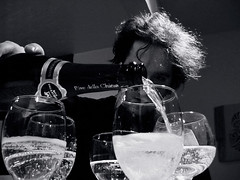Wine Blending
Yesterday, two friends and I got a chance to participate in a wine blending session with a couple of local winemakers at The Tasting Room which highlights a handful of Washington Wineries.
Paul Beveridge, of Wilridge Winery, and Don Corson of Camaraderie Cellars, poured the participants generous Washington barrel samples of the five Bourdeaux varietals* and asked us to blindly sample them. Amy loved what turned out to be the Petit Verdot, whereas Derek and I both found it to be the least appetizing of set (it wasn't lacking as much fruit character as was suggested it might, but its spiciness put it way out of the safety zone for my palette). Derek's favorite was the Cabernet Sauvignon and I preferred the Cabernet Franc. Blind tastings are something of an anomaly when you consider the typical drinking experience, but two of the things they do so well are to highlight and celebrate the differences in people's preferences and palettes.
After revealing the identities of the wines to us (only one person out of about twenty was able to guess all five of them correctly), we were given a chance to blend and taste them to our hearts' content.
I at first made some insultingly awful blends -- something I hadn't realized was so easy to do -- while the woman sitting next to me made a wonderful blend on her first time. Amy made a blend that was mostly Petit Verdot, which is, well, rare to say the least. While I didn't try it, I'll trust that it was good.
By the time Mr. Beveridge handed us a glass of his personal blend named Mélange (which is a killer wine, by the way), I had found that, for me, Merlot was much easier to start with as a base than, say, Cabernet Franc. That is, my blends that were heavier on the softer, less spicy wine seemed to be much more forgiving. None of this is a surprise, of course, but experimenting directly in that manner was much more reinforcing than tasting blended wines and reading about them.
If you subscribe to The Tasting Room's mailing list, you can get early notification of events like these. This is the first of any I've been to, and I must say it was very much worth the $25 (!).
*The Bourdeaux varietals, meaning the types of grapes that typically appear in the red wines of Bourdeaux, are Cabernet Sauvignon, Merlot, Cabernet
Franc, Petit Verdot and Malbec. All of these grapes are grown in France, California, Washington, and Oregon -- among other places.
Paul Beveridge, of Wilridge Winery, and Don Corson of Camaraderie Cellars, poured the participants generous Washington barrel samples of the five Bourdeaux varietals* and asked us to blindly sample them. Amy loved what turned out to be the Petit Verdot, whereas Derek and I both found it to be the least appetizing of set (it wasn't lacking as much fruit character as was suggested it might, but its spiciness put it way out of the safety zone for my palette). Derek's favorite was the Cabernet Sauvignon and I preferred the Cabernet Franc. Blind tastings are something of an anomaly when you consider the typical drinking experience, but two of the things they do so well are to highlight and celebrate the differences in people's preferences and palettes.
After revealing the identities of the wines to us (only one person out of about twenty was able to guess all five of them correctly), we were given a chance to blend and taste them to our hearts' content.
I at first made some insultingly awful blends -- something I hadn't realized was so easy to do -- while the woman sitting next to me made a wonderful blend on her first time. Amy made a blend that was mostly Petit Verdot, which is, well, rare to say the least. While I didn't try it, I'll trust that it was good.
By the time Mr. Beveridge handed us a glass of his personal blend named Mélange (which is a killer wine, by the way), I had found that, for me, Merlot was much easier to start with as a base than, say, Cabernet Franc. That is, my blends that were heavier on the softer, less spicy wine seemed to be much more forgiving. None of this is a surprise, of course, but experimenting directly in that manner was much more reinforcing than tasting blended wines and reading about them.
If you subscribe to The Tasting Room's mailing list, you can get early notification of events like these. This is the first of any I've been to, and I must say it was very much worth the $25 (!).
*The Bourdeaux varietals, meaning the types of grapes that typically appear in the red wines of Bourdeaux, are Cabernet Sauvignon, Merlot, Cabernet
Franc, Petit Verdot and Malbec. All of these grapes are grown in France, California, Washington, and Oregon -- among other places.














0 Comments:
Post a Comment
<< Home